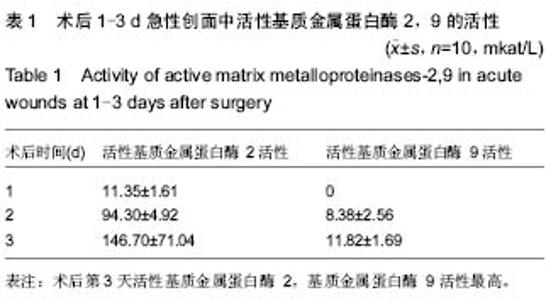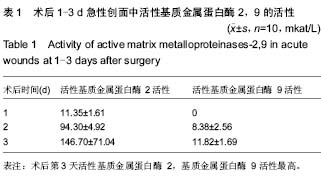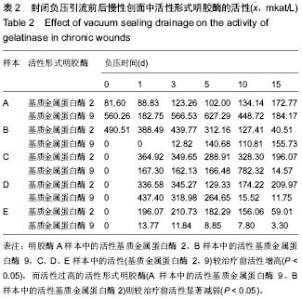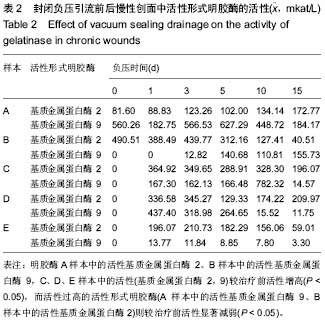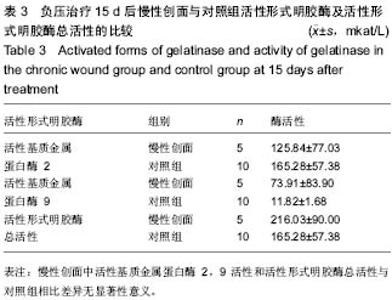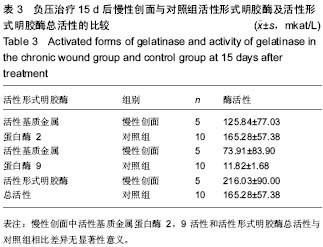| [1] 钱晓玲,周学芹,尹晓莉.封闭负压引流干预慢性创面神经生长因子和微血管的变化[J].中国组织工程研究,2014,11(5): 1647-1652.
[2] 曾勇,简华刚,宗建春.封闭负压引流技术对人慢性创面组织中C-ski及Smad3表达的影响[J].第三军医大学学报,2010,7(4): 704-707.
[3] 王红英,李海珍,孙淮庆.银离子敷料结合自制负压封闭引流技术在糖尿病足溃疡中的应用[J].浙江医学,2015,(1):72-74.
[4] 李国瑞,陈琳,刘沙.负压封闭引流对兔颅骨外露创面愈合效果的实验研究[J].现代生物医学进展,2014,(14):2640-2645.
[5] 李振刚,周媛,夏回容.持续性封闭式负压引流装置用于皮肤移植术的临床疗效[J].临床和实验医学杂志,2014,13(19): 1626- 1628.
[6] 苏晖,杨艳秋,宋海艳.负压封闭引流技术在软组织缺损难愈创面中的应用和护理[J].中国美容医学,2014,23(14):1215-1216.
[7] 陈其庆,姜平.封闭负压引流技术在急慢性创面修复及植皮前后辅助治疗中的研究及应用进展[J].广东医学,2011,22(13): 3004-3006.
[8] 徐海栋,赵建宁,卢俊浩,等.创面敷料封闭负压引流治疗慢性创面[J].中国组织工程研究,2013,16(5):3026-3032.
[9] Amul B, Atul S, Ravi G, et al. Digital photography and transparency-based methods for measuring wound surface area. Indian J Surg. 2014;752(7):123-189.
[10] 梁献平,马永奇.封闭负压引流技术对猪皮肤软组织海水浸泡爆炸伤创面愈合的病理学影响研究[J].中国美容整形外科杂志, 2014,25(10):633-637.
[11] 孙家驹.封闭负压引流技术(VSD)修复慢性压疮创面的临床研究[J].中国伤残医学,2014,22(21):7-8.
[12] 曹学秀.闭式负压引流术应用于骨科不愈合创面的护理[J].中国基层医药,2014,(12):1919-1920.
[13] 柳申鹏,万广,梁秋冬,等.外固定架结合泡沫敷料覆盖负压引流修复软组织严重损伤的四肢开放性骨折[J].中国组织工程研究, 2014,18(44):7157-7161.
[14] 柴益民.感染创面负压封闭引流技术的应用[J].中华显微外科杂志,2014,37(3):212-215.
[15] 顾立强.复杂性创面中负压封闭引流技术的应用[J].中华显微外科杂志,2014,37(3);217-218.
[16] 徐海栋,赵建宁,卢俊浩.基于生物材料创面敷料封闭负压引流在创伤性骨髓炎治疗中的应用[J].中国组织工程研究,2012,12(8): 2189-2192.
[17] 黄智勇,陈大夫,钟宇,等.自制简易封闭负压引流装置结合刃厚皮移植治疗深度烧伤[J].华西医学,2011,10(15):1468-1469.
[18] 徐敏超,郑琼,陈明.皮瓣移植结合封闭式负压引流修复下肢皮肤及软组织缺损[J].中国组织工程研究,2012,53(11): 10055- 10062.
[19] 师俊莉,席文锦,易成刚.封闭负压引流促进猪腹部爆炸伤创面愈合的实验研究[J].细胞与分子免疫学杂志,2014,(3):312-315.
[20] 刘桂喜,李少君,周淑娟,等.负压封闭引流技术在168例难愈合创面的应用及护理[J].武警后勤学院学报:医学版,2014,(2): 160-161.
[21] 姚辉,卢华定,徐义春,等.高分子泡沫材料负压封闭引流修复足踝部皮肤软组织缺损[J].中国组织工程研究,2014,18(16): 2607- 2612.
[22] 李晨,喻爱喜,白育庭,等.负压封闭引流对创面愈合和血浆纤维连接蛋白水平的影响[J].中华实验外科杂志,2014,31(1):190-191.
[23] 殷学利.利福霉素联合封闭负压引流对溃疡型淋巴结核创面愈合的研究[J].重庆医学,2014,43(2):150-151.[24] 刘宸赫,张永红,郭向宏. RNPT设备及材料修复创伤性软组织缺损[J].中国组织工程研究与临床康复,2011,38(18):7170-7174.
[25] 流小舟,徐海栋,赵建宁.生物与合成敷料封闭负压引流促进植皮创面愈合的对比[J].中国组织工程研究,2014,8(6):1295-1300.
[26] 赵继宏.负压封闭引流及皮片移植修复胫腓骨骨折的皮肤软组织缺损[J].中国组织工程研究,2014,18(20):3246-3251.
[27] 邱学文.封闭负压引流对兔压力性溃疡创面组织水肿及血流量的影响[J].广西医学,2014,36(5):599-601.
[28] 贾阳.负压创面治疗法作用原理及临床应用研究进展[J].中国美容医学,2014,23(14):1217-1221.
[29] 李晨阳,马兵.负压引流技术在临床应用中的研究进展[J].华西医学,2011,10(16):1461-1465.
[30] 龚震宇,冯小艳,熊锐华,等.封闭负压引流对兔放射性溃疡创面愈合的影响[J].海军医学杂志,2015,36(1):16-19.
[31] 钱李科.扩创植皮联合负压封闭引流治疗烧伤患者后期感染难愈创面的效果分析[J].医学美学美容:中旬刊,2015,24(1): 256-256.
[32] Woo KY, Kwong EW, Jimenez C, et al. Topical Agents and Dressings for Pilonidal Sinus Wound Healing by Secondary Intention: A Scoping Review. Surg Technol Int. 2015;26: 57-63.
[33] Chandra PK, Ross CL, Smith LC, et al. Peroxide-based oxygen generating topical wound dressing for enhancing healing of dermal wounds. Wound Repair Regen. 2015.
[34] Greaves NS, Iqbal SA, Hodgkinson T, et al. Skin substitute- assisted repair shows reduced dermal fibrosis in acute human wounds validated simultaneously by histology and optical coherence tomography. Wound Repair Regen. 2015. doi: 10.1111/wrr.12308.
[35] Itani HE. Reviewing the benefits and harm of NPWT in the management of closed surgical incisions. Br J Community Nurs. 2015;20 Suppl 6:S28-S34.
[36] Lönnqvist S, Emanuelsson P, Kratz G. Influence of acidic pH on keratinocyte function and re-epithelialisation of human in vitro wounds. J Plast Surg Hand Surg. 2015:1-7.
[37] do Nascimento-Neto LG, Vasconcelos Evaristo FF, de Alencar Alves, et al. Effect of the triterpene 3β, 6β, 16β-trihydroxylup-20(29)-ene isolated from the leaves of Combretum leprosum Mart. on cutaneous wounds in mice. J Ethnopharmacol. 2015.
[38] Gainza G, Chu WS, Guy RH, et al. Development and in vitro evaluation of lipid nanoparticle-based dressings for topical treatment of chronic wounds. Int J Pharm. 2015.
[39] Kleinman WB. Physical Examination of the Wrist: Useful Provocative Maneuvers. J Hand Surg Am. 2015.
[40] Rammelt S, Goronzy J. Subtalar Dislocations. Foot Ankle Clin. 2015;20(2):253-264.
[41] van Koppen CJ, Hartmann RW. Advances in the treatment of chronic wounds: a patent review. Expert Opin Ther Pat. 2015: 1-7. |
